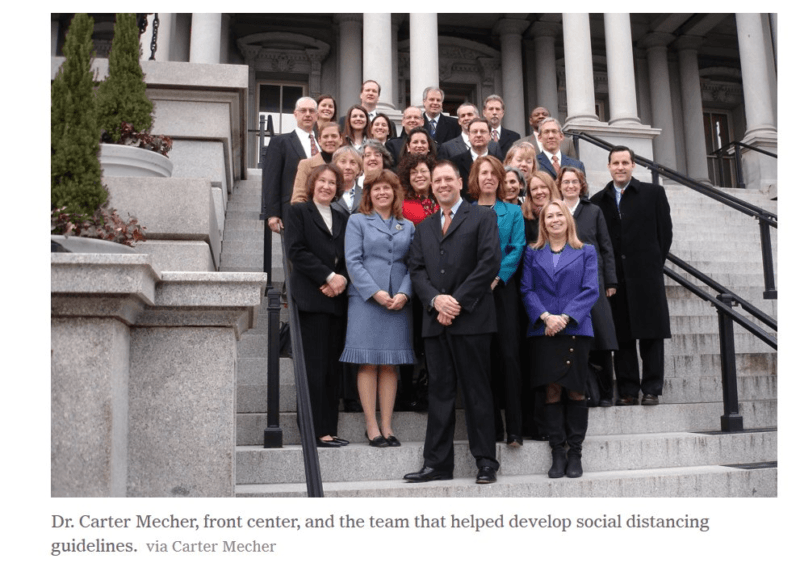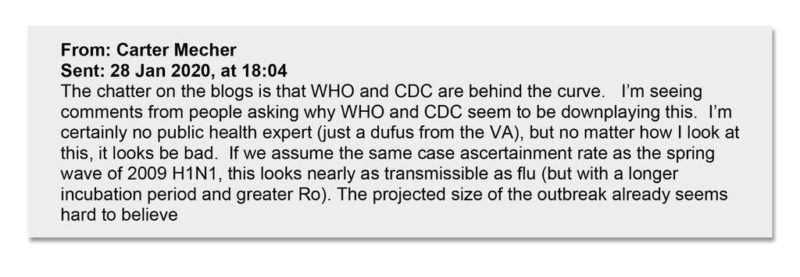The idea of a full lockdown of society in the event of a pandemic first emerged as an extremist proposal in 2006, issued by a computer scientist as part of George W. Bush’s preparations for biowarfare. It provoked a fierce response by the world’s leading epidemiologist Donald Henderson and his colleagues. That proposal, issued by Robert Glass under the influence of his daughter’s high school science fair project (yes, it thanks Neil Ferguson for comments), would sit for 14 years before being deployed in some form during the political panic of March 2020.
The blueprint document – more moderate than the Glass paper but still draconian – that sat lying in wait in the intervening years was issued in February 2007: Interim Pre-pandemic Planning Guidance: Community Strategy for Pandemic Influenza Mitigation in the United States— Early, Targeted, Layered Use of Nonpharmaceutical Interventions.
This document introduced the new lexicon: Targeted Layered Containment (TLC), Non-Pharmaceutical Interventions (NPIs), Social Distancing, Flatten the Curve. By the middle of March 2020, all of these strange phrases were on the lips of every news broadcaster and politician.
It was new vocabulary for new times which rejected the non-government solutions used in every pandemic since World War II. Hereafter, government would be hands-on with precision policies that infringe on liberties and property, with the presumption that under emergency conditions, government can do essentially anything that it wants.
This document did not push a hard lockdown but it did call for closures of all schools and large events, in addition to:
Voluntary home quarantine of members of households with confirmed or probable influenza case(s) and consideration of combining this intervention with the prophylactic use of antiviral medications, providing sufficient quantities of effective medications exist and that a feasible means of distributing them is in place.
On its face, there is nothing inherently threatening about a voluntary home quarantine of the sick. All of this happens in any case, normally and naturally, in all seasons in which viruses and bacteria threaten health, which is to say always. It requires no governing directives. There is no reason for government to weigh in on the matter at all.
However, matters are different with other directives from this 2007 document, including:
* Dismissal of students from school (including public and private schools as well as colleges and universities) and school-based activities and closure of childcare programs, coupled with protecting children and teenagers through social distancing in the community to achieve reductions of out-of-school social contacts and community mixing.
* Use of social distancing measures to reduce contact between adults in the community and workplace, including, for example, cancellation of large public gatherings and alteration of workplace environments and schedules to decrease social density and preserve a healthy workplace to the greatest extent possible without disrupting essential services. Enable institution of workplace leave policies that align incentives and facilitate adherence with the nonpharmaceutical interventions (NPIs) outlined above.
While these measures might seem moderate by comparison to what happened in March 2020, these directives arguably led to lockdown just by the logic of intervention and the general theory that viruses should be defeated by overriding private decision-making and forced human separation.
In a market-based free society, everything is connected and one closure leads to another. Dismiss the schools and the kids hang out in malls, beaches, and parks. You have to close them to maintain distancing. If they stay home, they need a parent home, which puts pressure on businesses to close. If you are closing “large public gatherings” you still have a problem with churches, picnics, conventions of any size, and even large dinner parties. Transportation has to shut down, including flights, trains, and subways. A consistent application of the logic here – that the way to mitigate disease is to stay away from people – requires a complete shutdown of society.
And to what end? Epidemiologists will tell you that viruses don’t just get bored and go away. Natural immunity requires the building of antibodies to the virus. Then there is the option of vaccines, which have historically been long in the discovery, distribution, and administration. The first smallpox vaccine appeared in 1796; the disease wasn’t declared eradicated until 1980. But to the authors of the 2007 CDC directive, vaccines are the end game, even without evidence that they are possible in the case of new viruses such as COVID-19.
The point of closures, said the CDC, is to “delay the exponential growth in incident cases and shift the epidemic curve to the right in order to ‘buy time’ for production and distribution of a well-matched pandemic strain vaccine.”
To be sure, back in 2006 and 2007, there were plenty of serious protests against this whole line of thinking. Some experts called it disruptive, dangerous, and potentially calamitous, and pushed instead the old wisdom we had learned after World War II: disease mitigation efforts should be handled by medical professionals, not politicians. When the 1957-58 Asian flu broke out (eventually killing 116,000 Americans), for example, the New York Times expressed the common wisdom: “Let us all keep a cool head about Asian influenza as the statistics on the spread and the virulence of the disease begin to accumulate.” That was the one editorial the paper ran on the topic. It was the opposite of a media frenzy.
Lockdowns, as well as all this language and apparatus that amount to a primal scream to run and hide from the virus, were once considered bad law and bad medicine, and thus completely out of the question. The general rule was to stay calm, get immunities, and move forward with life without disruption. And there is where matters stood all these years, just waiting to be deployed by a handful of guardians of the strategy to undertake a great experiment in massive public control.
Beginning in January of this year, as news of COVID-19 was pouring out of Wuhan, China, many of those who were involved in crafting this policy in 2007 began to sense an opportunity. As the New York Times explains:
As the coronavirus emerged and headed toward the United States, an extraordinary conversation was hatched among an elite group of infectious disease doctors and medical experts in the federal government and academic institutions around the nation.
Red Dawn — a nod to the 1984 film with Patrick Swayze and Charlie Sheen — was the nickname for the email chain they built. Different threads in the chain were named Red Dawn Breaking, Red Dawn Rising, Red Dawn Breaking Bad and, as the situation grew more dire, Red Dawn Raging. It was hosted by the chief medical officer at the Department of Homeland Security, Dr. Duane C. Caneva, starting in January with a small core of medical experts and friends that gradually grew to dozens.
One of the most active participants on this thread was Carter Mecher, a Chicago physician who has long worked for the Veterans Administration as an advisor. He was actively involved in crafting the 2007 CDC document on school shutdowns and forced human separation.

Mecher had been a convert to the ideas of Robert and Sarah Glass and their blueprint for full lockdown. With the Glass father and daughter out of the picture, it was left to Mecher to push hard for a new approach to handling viruses. He more than anyone in the email thread posted often and with rising passion.
On January 28, 2020, he sent the following note.

The following month, he was already talking up Non-Pharmaceutical Interventions, a broad phrase that can mean everything from voluntary self-quarantine all the way to full lockdown.

The same day, Mecher began to promote the pro-lockdown work of Robert Glass:
“Lastly, another person, Bob Glass at Los Alamos, also did work on this separately from the MIDAS group. He actually began this work as part of a science fair project for his daughter (using social contacts of his daughter and her classmates at school to model disease transmission). He knew someone at VA who forwarded his work to us (chain of transmission). Early on (even before the MIDAS group modeled TLC ), we had a Eureka moment when we graphed his data in Excel ( can share that single graph to anyone interested).
After this, the tone and tenor of the group grew ever more fiery to the point of absolute frenzy. They needed the disease threat as intense as possible in order to kick off their plans, and they were probably sincere in believing it was time. As with any long email chain, there eventually emerges one tone setting and driver of discussion. In this case, Mecher became the main voice for panic and immediate deployment of the shutting of schools and public events, leading to lockdowns all over the country. .
If you have any doubt that the main push for the lockdown was less about therapy than models, inspired by the fantasies of a computer scientist rather than a genuine expert in viruses, a social experiment conducted with disregard for freedom and the rule of law, a wild and foolhardy central plan hatched without regard to experience or serious medical science, this email chain as passionate demand to implement the 2007 CDC blueprint is the proof.
Now the architects of 2007 are working themselves to socially distance from the lockdowns that have wrought so much damage to the country. I’m not so sure if they can or deserve to be declared free of responsibility. How many terrible atrocities in wartime result from a policy that began with a promise of only surgical strikes and precision bombings with no other casualties? We see something similar taking place here. Culpability belongs to those who unleash violence in the name of peace, or health.
Jeffrey A. Tucker is Editorial Director for the American Institute for Economic Research. He is the author of many thousands of articles in the scholarly and popular press and eight books in 5 languages, most recently The Market Loves You. He is also the editor of The Best of Mises. He speaks widely on topics of economics, technology, social philosophy, and culture. Jeffrey is available for speaking and interviews via his email. Tw | FB | LinkedIn
Source: AIER.org
Jeffrey A. Tucker is Editorial Director for the American Institute for Economic Research. He is the author of many thousands of articles in the scholarly and popular press and eight books in 5 languages, most recently The Market Loves You. He is also the editor of The Best of Mises. He speaks widely on topics of economics, technology, social philosophy, and culture. Jeffrey is available for speaking and interviews via his email. Tw | FB | LinkedIn
 By
By